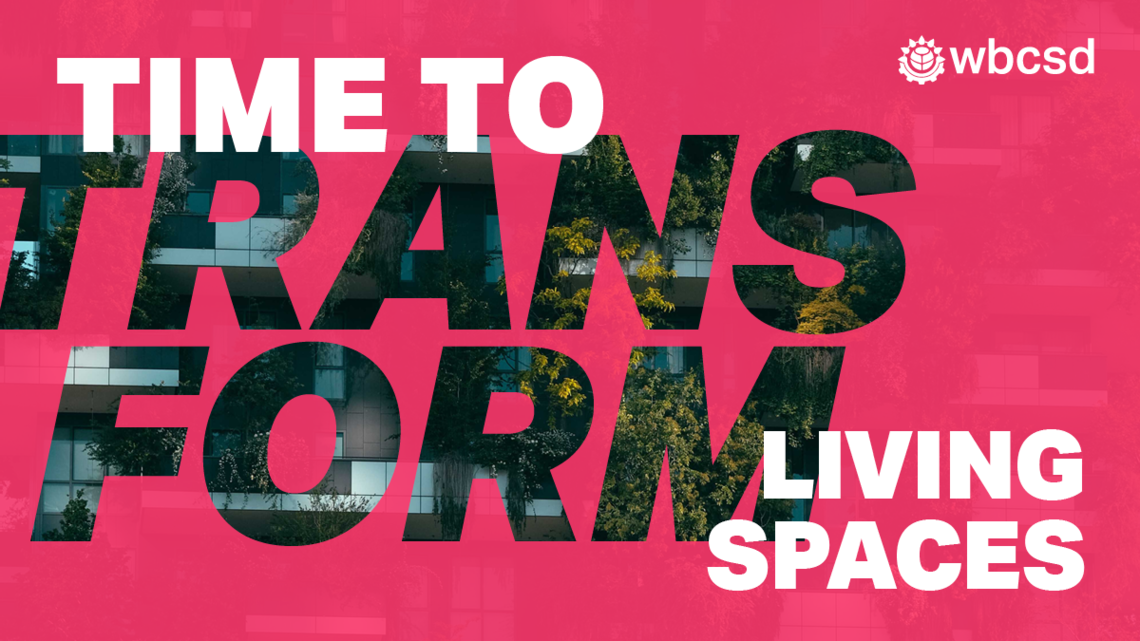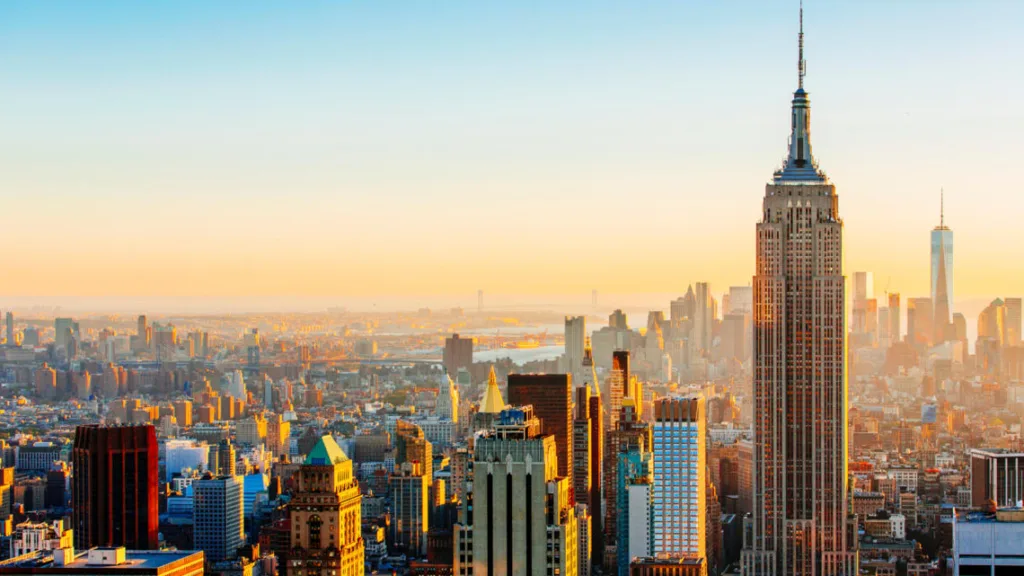Authors
Bill Sisson
By Bill Sisson, Executive Director, North America at the World Business Council for Sustainable Development (WBCSD)
Vision 2050: Time to Transform is WBCSD’s framework for business action in line with the urgency of the challenges that we face as global societies. Developed with 40 of our members, it offers companies comprehensive and ambitious guidance on how they can lead the transformations needed to bring about a world in which 9+ billion people can live well, within planetary boundaries, by 2050. The Living Spaces pathway – the built environment – is one of nine transformation pathways at the heart of Vision 2050: Time to Transform.
Living spaces are the areas where people reside, work, and spend their leisure time. People’s living spaces play important roles in their physical and psychological health, their relationships and the quality of their work.
Vision 2050’s Living Spaces transformation pathway considers the needs of both urban and rural communities, outlining the public and private sector efforts needed to provide adequate housing, workplaces, and spaces for leisure and community engagement. Our vision is for “healthy and inclusive living spaces, thriving in harmony with nature.” The vision further explores how the societal needs from Living Spaces will be met in 2050, requiring business to work to create:
- Living spaces that promote health and wellbeing.
- Affordable housing and communities that work for all.
- A net-zero carbon built environment that is resilient adaptable and regenerative.
- Living spaces that harness the potential of recycled and renewable materials.
To be on track with our vision, we must at least halve the emissions from the built environment sector by 2030; achievable through focus and collaboration by all involved. Progress is being made but at present, our buildings and living spaces continue to contribute to the climate crisis, nature loss and inequality. The building and construction sector alone is responsible for almost 40% of global energy-related greenhouse gas emissions, over 40% of global resource use and 40% of global waste streams. At the same time, close to 1 billion people worldwide live in slums and make-shift homes, aspiring to find safe and affordable dwellings. By 2050, the global building floor area is expected to double, with over 5 billion square meters being added every year, driven by rapid urbanization and growing space-demand.
Living spaces are critical to our wellbeing – something that has become much more apparent during the COVID-19 pandemic. In fact, according to the US Environmental Protection Agency, in the US people spend an average of 90% of their time indoors. The transformation of the built environment toward healthier living spaces began before the pandemic, and continues to accelerate. An April 2021 global survey of leading real estate owners and investors, sponsored by the United Nations Environment Programme Finance Initiative, found that 92% of respondents expect the demand for healthy buildings to grow over the next three years. This demand for healthier living spaces is leading to transformation in commercial and residential buildings. It can also help drive sustainable practice.
The way we construct our homes, choose materials, or heat and cool them affects both our personal health and the environment. At the city level, well-planned, green areas, like parks, playgrounds and indoor greenery, can minimize health risks from air pollution, promote physical activity, alleviate stress and reduce noise and excessive heat, while at the same time mitigating climate change. There are now an increasing number of businesses supporting the design and construction of our living spaces in healthy and sustainable ways. For example, Gensler, a global design firm and new WBCSD member, is behind the Houston Advanced Research Center Living Lab, the first commercial building in Texas, US, to receive Zero Energy Certification. Other WBCSD members are also putting into practice sustainable built environment solutions from affordable and sustainable material for housing to energy-positive buildings and innovative and inclusive mass transit solutions.
Business can signal market demand for living spaces that simultaneously address the climate crisis, inequality and nature loss. Progress must be seen by 2030, a little more than eight years from now, but there are significant challenges to be overcome. For instance, building projects do not currently calculate and report their full carbon footprint. If all companies started measuring emissions across the whole life cycle of their real estate assets, as well as increase data sharing, collaboration and transparency, we would be able to set clear targets and drive the carbon emissions reduction needed in the next decade. But these reductions really need to accelerate, starting today.
WBCSD’s Transforming the Built Environment project brings together leading companies to overcome value chain fragmentation and establish pathways for fully decarbonized, circular and nature-based living spaces. Our members include material manufacturers, design firms, construction companies, real estate developers, investors and end-users. We share knowledge and develop guidance and tools of global relevance to support action and strengthen the business case. We also advocate for actions and policies supporting market transformation toward a net zero, circular and nature-based built environment.
The Living Spaces pathway can help a broad range of actors in urban planning, architecture, construction, material production, maintenance, real estate, retail, hospitality and leisure industries, to understand how and where they can play a role in driving the transformations that are needed. It lays out a comprehensive series of transitions that we consider critical to the achievement of our vision for Living Spaces: building and infrastructure design will have to shift to focus on users’ health and increasingly integrate and respect biodiversity; at the same time, cities and buildings will need to pave the way toward a net-zero carbon and climate-resilient world; we must implement ever more circular living spaces that minimize consumption and waste and ensure that our cities and rural areas are made to work for all, creating affordable housing in inclusive, safe, and secure neighborhoods; finally, business has to ensure that respect for human rights is embedded across the construction and materials sectors globally.
As well as these comprehensive transitions, the pathway proposes 10 prioritized action areas for business to focus on over the course of the next decade to accelerate the pace and scale of change. These action areas span innovative products, services, technologies and business models, as well as ways that companies can help create the right enabling conditions for change. They are not exhaustive but cover the most urgent and important priorities in the crucial decade ahead. Vision 2050’s 10 business action areas for the Living Spaces pathway are:
- Implement short-, medium- and long-term science-based targets to reduce the whole life carbon footprint of built structures toward net-zero emissions. Collaborate with clients, suppliers and all actors across the built environment to ensure targets are met and to drive net-zero construction and renovation measures.
- Contribute to the development of national and sectoral decarbonization roadmaps, and engage with authorities at the regional, national, and local levels to advocate for the, targets, building codes and planning, permitting and procurement processes needed for a sustainable built environment.
- Unlock the potential of digitalization to facilitate data recording and transfer among stakeholders and across life cycle stages to promote more holistic urban planning, greater transparency and enhanced efficiency across the built environment sector.
- Create ways for occupants to play a role in minimizing the environmental impacts of their living and working spaces.
- Develop circular business models to maintain the value of materials and resources throughout the lifetime of built structures. Innovate to make circular options more cost-competitive, convenient and dependable.
- Future-proof buildings and infrastructure to withstand environmental, social and health-related shocks through urban planning, performance standards and construction practices.
- Develop and adopt science-based targets for nature, which factor in impacts from material extraction to construction to building end-use. Integrate nature-based solutions into design and construction efforts.
- Innovate and collaborate on new techniques and models to ensure the delivery of quality affordable housing that promotes health and wellbeing, in both existing and new developments.
- Conduct and enhance due diligence in line with the UN Guiding Principles on Business and Human Rights with a view to respecting human rights and ensuring decent working conditions throughout the construction value chain, including in the informal economy.
- Develop comprehensive strategies to support a just transition for workers that may be affected by emerging construction methods, materials and technologies.
These actions are all aligned with the achievement of the Sustainable Development Goals, translating SDG ambitions and targets into clearly actionable areas of business activity.
Join us in our shared vision and in driving collaboration across the above priority action areas, so that, together, we can make the world feel at home.
VISION 2050 INSIGHT SERIES
This article is part of an ongoing insight series into WBCSD’s Vision 2050: Time to Transform.
Introduction: Julian Hill-Landolt, Director, Vision 2050, introduces the Vision 2050: Time to Transform insight series and provides an overview of the topics that will be covered.
Living Well: Filippo Veglio, Managing Director, People & Society, takes a deeper look at what it means to “live well” – a world in which everyone’s dignity and rights are respected, basic needs are met, and equal opportunities are available for all.
Living within Planetary Boundaries: Diane Holdorf, Managing Director of the Food & Nature Program, and Claire O’Neill, Managing Director of the Climate & Energy Program, take a deeper look at what it means to “live within planetary boundaries”.
We can provide healthy diets for all: Diane Holdorf, Managing Director of the Food & Nature Program, explores Vision 2050’s Food pathway.
We can connect people: Constant van Aerschot, Director WBCSD Asia Pacific, talks with Fujitsu’s Mel Melis about Vision 2050’s Connectivity pathway.
We can keep the water flowing: Joe Phelan, Director WBCSD India, provides an overview of our Water & Sanitation pathway and reflects on its importance in India.
We can keep on moving, smarter: Wei Dong Zhou, Director WBCSD China, interviews WBCSD’s Director Mobility Thomas Deloison about Vision 2050’s Transportation & Mobility pathway.
We can make things, smarter: Federico Merlo, Managing Director Member Relations and Circular Economy, digs into the Products & Materials pathway and WBCSD’s work in this space
Next Up: Rodney Irwin, Chief Operating Officer at WBCSD, will offer a deeper look into Vision 2050’s Financial Products & Services pathway.
WBCSD news articles and insights may be republished in accordance with the Creative Commons Attribution-NonCommercial-NoDerivatives 4.0 International Public License, and in accordance with our Privacy Policy. All Content must be featured with due credits.

